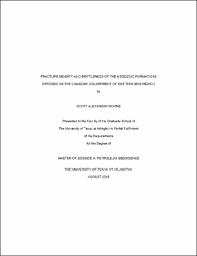
ATTENTION: The works hosted here are being migrated to a new repository that will consolidate resources, improve discoverability, and better show UTA's research impact on the global community. We will update authors as the migration progresses. Please see MavMatrix for more information.
Show simple item record
| dc.contributor.advisor | Wickham, John | |
| dc.creator | Moore, Scott Alexander | |
| dc.date.accessioned | 2019-02-06T15:34:58Z | |
| dc.date.available | 2019-02-06T15:34:58Z | |
| dc.date.created | 2018-08 | |
| dc.date.issued | 2018-07-02 | |
| dc.date.submitted | August 2018 | |
| dc.identifier.uri | http://hdl.handle.net/10106/27662 | |
| dc.description.abstract | Production of hydrocarbons from tight and unconventional reservoirs has become so prevalent, the need to understand rock fracture mechanics has become increasingly important. A specific research goal is the need to understand fracture density and brittleness and what can affect the two. Fracture density is defined as the fracture surface area per unit volume and is calculated from strain energies and material properties of the rocks. Brittleness has been defined as the fracture density at a particular strain state (Wickham et al., 2013).There are three goals for this study. One is to use the dimensionless geomechanical fracture density equation, (F_d K²IC)/(4μ² (1+ν))=A υ/(1-2υ)+B, to test whether the strain conditions were constant in the sampled stratigraphic layers. If strain conditions were constant, then the data will plot as a straight line with a positive slope where A is the slope of the line and B is the intercept. A and B are estimates of the strain state as a function of the strain invariants. Another goal is to compare a brittleness equation commonly used in the industry, B₁₉ =(E_n+υ_n)/2 (Equation 1), and the geomechanical equation, F_d=(4μ² (1+υ))/(K²IC) [A υ/(1-2υ)+B] (Equation 4). All layers were ranked according to their brittleness using the two equations. If the two methods are equivalent, the ranking should be the same. The advantage of the geomechanical equation (Equation 4) is that the results are based on established fracture mechanics equations and not intuitive relationships. A third goal is to directly measure fracture toughness using a method recommended by the International Society of Rock Mechanics, the Cracked Chevron Notched Brazilian Disc Test (CCNBD) and compare those measured values with values calculated using an equation that correlates fracture toughness with Young’s Modulus (Whittaker, 1993) and see if the two methods correlate with one another.Fracture density measurements were taken at a road-cut in the Tucumcari Basinon the Canadian Escarpment in East Central New Mexico. The road-cut is located on NM Highway 104 and is about 30 miles east of Las Vegas, NM. Samples were collected and brought back to UTA to measure density, fracture toughness, and dynamic material properties (Poisson’s Ratio, Young’s Modulus, and Shear Modulus) calculated from P and S wave velocities. Results show that the measured stratigraphic layers were subject to constant strain, the fracture density brittlness and the Jin et al., (2014) brittleness calculations did not correlate, and that the fracture toughness values obtained from the CCNBD did correlate well with the values obtained for fracture toughness using the Young’s Modulus correlation equation (Whittaker et al.,1993). | |
| dc.format.mimetype | application/pdf | |
| dc.language.iso | en_US | |
| dc.subject | Fracture | |
| dc.subject | Density | |
| dc.subject | Fracture density | |
| dc.subject | New Mexico | |
| dc.subject | Mesozoic | |
| dc.subject | Brittleness | |
| dc.title | FRACTURE DENSITY AND BRITTLENESS OF THE MESOZOIC FORMATIONS EXPOSED ON THE CANADIAN ESCARPMENT OF EASTERN NEW MEXICO | |
| dc.type | Thesis | |
| dc.degree.department | Earth and Environmental Sciences | |
| dc.degree.name | Master of Science in Earth and Environmental Science | |
| dc.date.updated | 2019-02-06T15:34:59Z | |
| thesis.degree.department | Earth and Environmental Sciences | |
| thesis.degree.grantor | The University of Texas at Arlington | |
| thesis.degree.level | Masters | |
| thesis.degree.name | Master of Science in Earth and Environmental Science | |
| dc.type.material | text | |
| dc.creator.orcid | 0000-0002-1682-2530 | |
Files in this item
- Name:
- MOORE-THESIS-2018.pdf
- Size:
- 6.643Mb
- Format:
- PDF
This item appears in the following Collection(s)
Show simple item record


